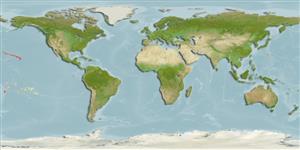>
Mulliformes (Goatfishes) >
Mullidae (Goatfishes)
Etymology: Parupeneus: Latin, parum, parvum = small + Peneus, the name of a river; chrysonemus: Named for its golden yellow barbels..
More on authors: Jordan & Evermann.
Environment: milieu / climate zone / depth range / distribution range
Ecologia
marinhas demersal; intervalo de profundidade 20 - 183 m (Ref. 54393), usually 60 - ? m. Tropical
Eastern Central Pacific: Hawaii and Johnston islands.
Tamanho / Peso / Idade
Maturity: Lm ? range ? - ? cm
Max length : 19.6 cm SL macho/indeterminado; (Ref. 54393)
Espinhos dorsais (total): 8; Raios dorsais (total): 9; Raios anais : 7. Diagnosis: Pectoral rays nearly always 16 (4 of 36 specimens with 15 on one side and 17 on the other). Gill rakers 7-8 + 25-28 (total 32-35). Body depth 3.3-4.05 in SL; head length (HL) 2.7-3.05 in SL; eye relatively large, the orbit diameter 4.4 - 5.3 in HL (118-196 mm SL); snout length 1.65-2.1 in HL (snout progressively longer with growth); barbel long 1.1-1.3 in HL; dorsal spine longest in HL; last dorsal rays about equal in length; pectoral-fin length 1.35-1.5 in HL; pelvic fins 1.2-1.4 in HL. White, scale edges narrowly dark, with a red or brown band from front of snout along back adjacent to base of dorsal fins, the scales within band with dark brown edges, and many with a dark brown spot; a red or dark brown stripe from front of snout through eye and broadening as it follows the lateral line; stripe partially interrupted below rear base of second dorsal fin, then ending in a broad slightly oblique bar on caudal peduncle; a vertically elongate dark red or dark brown spot within stripe behind eye in line with posterior margin of preopercle; barbels varying from bright red to yellow or mixed red and yellow; membranes of first dorsal fin red; second dorsal fin red basally, the outer half with narrow irregular pale yellow and pale blue bands separated by dark reddish lines; anal fin with similar bands on all of fin; caudal fin mainly yellow, usually with small white spots basally; pelvic fins largely red. Specimens from the deep water are entirely red without upper band and lateral stripe; a dark red spot behind eye; fins colored as in shallower-water fish except caudal fin more red (Ref. 54393).
Found over sand (Ref. 58302). Generally found at depths deeper than 60 meters (Ref. 54393).
Ciclo de vida ou comportamento de acasalamento
Maturidade | Reprodução | Desova | Ovos | Fecundidade | Larvas
Randall, J.E., 2004. Revision of the goatfish genus Parupeneus (Perciformes: Mullidae), with descriptions of two new species. Indo-Pac. Fish. (36):64 p. (Ref. 54393)
Status na Lista Vermelha da UICN (Ref. 130435)
Ameaça para os humanos
Harmless
Uso pelos humanos
Mais informação
Nomes comunsSinônimosMetabolismoPredadoresEcotoxicologiaReproduçãoMaturidadeDesovaAgregação de desovaFecundidadeOvosDesenvolvimento dos ovos
ReferênciasAquaculturaPerfil para aquaculturaEstirpesGenéticaElectrophoresesHereditariedadeDoençasProcessamentoNutrientsConversão de massa
ColaboradoresFotosStamps, Coins Misc.SonsCiguateraVelocidadeTipo de nataçãoÁrea branquialOtólitosCérebrosVisão
Ferramentas
Relatórios especiais
Baixar XML
Fontes da internet
Estimates based on models
Preferred temperature (Ref.
123201): 7.5 - 20.2, mean 10.1 °C (based on 7 cells).
Índice de diversidade filogenética (Ref.
82804): PD
50 = 0.5000 [Uniqueness, from 0.5 = low to 2.0 = high].
Bayesian length-weight: a=0.01202 (0.00556 - 0.02601), b=3.10 (2.93 - 3.27), in cm total length, based on LWR estimates for this Genus-body shape (Ref.
93245).
Nível Trófico (Ref.
69278): 3.4 ±0.4 se; based on size and trophs of closest relatives
Resiliência (Ref.
120179): Elevada, tempo mínimo de duplicação da população menor que 15 meses (Preliminary K or Fecundity.).
Fishing Vulnerability (Ref.
59153): Low vulnerability (14 of 100).
Nutrients (Ref.
124155): Calcium = 131 [47, 384] mg/100g; Iron = 0.651 [0.305, 1.675] mg/100g; Protein = 17 [14, 20] %; Omega3 = 0.249 [0.125, 0.526] g/100g; Selenium = 91.3 [36.1, 252.8] μg/100g; VitaminA = 69.4 [12.9, 332.3] μg/100g; Zinc = 0.606 [0.337, 1.242] mg/100g (wet weight);
